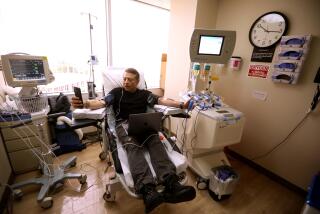PERSPECTIVE ON HEALTH : To Save on Treatment, Find the Cures : Of the billions we spend on health care, little goes for research. But that’s where the big payoffs come from.
“Damn near everyone in this country is sick!”
This “discovery” was made by a researcher on my staff who added up the numbers of Americans suffering from various diseases and found that the total exceeded by a good measure the entire population of the United States. Even more remarkable, his total was for physical ailments only; it did not include the estimated 30 million with mental illnesses and psychiatric disorders.
While a good statistician might argue my assistant’s conclusion that “everyone” is sick, his estimate is not far off the mark. Sad to say, the great majority of Americans are victims of chronic, crippling or incapacitating diseases ranging from alcoholism to Alzheimer’s. Sexually transmitted diseases alone have infected 40 million.
Even if the reported figures represent some overlap or overstatement, the bottom line is mind-boggling and the medical bill is enormous. Last year the United States spent nearly $600 billion for health care. That’s nearly 12% of our GNP--12% of the total value of all goods and services produced by the world’s wealthiest nation.
That we spend heavily on health is not at issue. Whether we spend wisely is. One of the biggest problems with our present health-care system is that it focuses so much on treatment and so little on prevention. We spend billions to buy hospital beds, antibiotics and ambulances, but we scrimp when it comes to investing in science to find the causes and cures for our costly maladies. Less than 3% of the health-care dollar is earmarked for the scientist at the bench.
Yet it is such basic research that provides the big payoffs. The virtual elimination in this century of such dread diseases as polio, tuberculosis, diphtheria, smallpox and measles has saved the country billions. Polio immunization and vaccines for measles, mumps and rubella, for example, have spared us more than $2 billion in expenses a year. In a very real sense, these vaccines have been a shot in the arm for the economy. Medical research historically offers an excellent return on taxpayer money. Studies show a $13 return for every research dollar invested by the federal government between 1900 and 1975.
There are other direct and indirect spinoffs. More than $40 billion is contributed annually to the GNP from medical discoveries used in non-health-related products. Medical research has spawned more than 100 new high-tech companies--the kind of economic development most needed to make America competitive and build a strong economic base for the future.
Perhaps it’s too simple--possibly too sensible--for our federal budget-makers to take seriously, but there is a very strong case to be made for using medical-research spending as a prescription for reducing the deficit. Polls show that a majority of Americans believe that government funds for medical research should be increased by a sizable amount--even in this tight-money era.
Public support would be even stronger if Congress better realized the economic benefits of better health. For instance, The annual cost of multiple sclerosis is at least $2 billion. That includes medical treatment, benefit payments and loss of income to the 250,000 Americans with MS and their families.
Because this crippler of young adults is a “lifetime” disease--people rarely die from it--its economic consequences are much greater than for some of the so-called killer diseases. Solving the mystery of how MS attacks the central nervous system would save the taxpayers billions in Medicare, Medicaid and SDI payments. It would also generate significant additional revenue for the Treasury by reducing dependency and putting the disabled back to work. The sick consume tax revenues; the healthy produce tax revenues.
Efforts to deal with soaring health expenditures currently center on cost-containment programs designed to reduce the duration of hospital stays and unnecessary surgery. Of course, every dollar saved is important. But considering the dimensions of the problem, this is like cutting the lawn with nail clippers.
Businessmen who need to cut overhead identify the biggest expense items in the company budget and then take steps to reduce them. For our country there is no larger expense item than health care. The $1.5 billion a day we now spend to care for the sick is the biggest single line item in the federal budget. Bigger even than defense. We spend $3,000 a year per American for health care. By contrast, the annual federal investment in biomedical research is only $35 per person.
Complete eradication of disease is, of course, not a realistic goal. But so many potential breakthroughs are now in sight that medical research should be steaming ahead at full speed. Yet for lack of funding, three out of four National Institutes of Health research applications judged highly meritorious by a peer-review procedure are going unfunded. The haunting worry is that one of those unfunded applicants might have found the cure for cerebral palsy or some other disease.
In his most famous work, “The Compleat Angler,” 17th-Century author Izaak Walton wrote that “health is a blessing money cannot buy.” But more money for research would indeed ensure better health for millions of Americans, born and unborn. Spending for biomedical research is smart politics, sound national policy and a good business investment.






